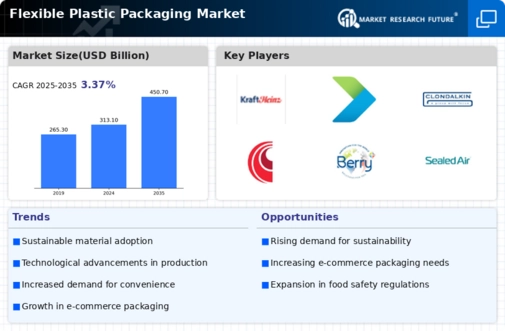Top Industry Leaders in the Flexible Plastic Packaging Market
 The flexible plastic packaging market is a dynamic and ever-evolving space, constantly adapting to changing consumer demands and environmental concerns. This adaptability is fueled by a fierce competitive landscape, where players of all sizes vie for market share through a diverse range of strategies. Let's delve into this vibrant ecosystem, examining the key players, their strategies, and the factors shaping the market's future.
The flexible plastic packaging market is a dynamic and ever-evolving space, constantly adapting to changing consumer demands and environmental concerns. This adaptability is fueled by a fierce competitive landscape, where players of all sizes vie for market share through a diverse range of strategies. Let's delve into this vibrant ecosystem, examining the key players, their strategies, and the factors shaping the market's future.
Strategies for a Flexible Edge:
-
Innovation Powerhouses: Major players like Amcor, Sealed Air, and Mondi are heavily invested in R&D, developing new materials and technologies that enhance functionality, sustainability, and shelf life. Think resealable pouches with extended shelf life for food products or stand-up pouches with improved barrier properties. -
Cost-Conscious Contenders: Companies like UFlex and Jindal Poly Films are focusing on cost-effective solutions, utilizing recycled materials and optimizing production processes to cater to price-sensitive segments and emerging markets. This strategy allows them to offer competitive pricing while maintaining quality standards. -
Niche Specialists: Smaller players are carving out their niches by focusing on specific applications or materials. Some specialize in high-performance films for medical devices, while others cater to the demand for biodegradable or compostable packaging solutions. This targeted approach allows them to excel in specific areas.
Factors Shaping Market Share: A Balancing Act
-
Product Diversification: Offering a wide range of formats, from pouches and bags to rolls and films, caters to diverse needs across various industries, from food and beverage to pharmaceuticals and cosmetics. This broadens the customer base and increases market share potential. -
Sustainability Focus: The growing awareness of environmental issues is pushing manufacturers towards adopting sustainable practices. This includes using recycled materials, developing biodegradable options, and minimizing packaging waste. Companies that prioritize sustainability resonate with eco-conscious consumers and gain a competitive edge. -
Technological Advancements: Integrating smart features like QR codes and near-field communication (NFC) technology enhances brand engagement and provides valuable data on consumer behavior. This opens up new marketing opportunities and strengthens brand loyalty. -
Regional Adaptations: Understanding cultural nuances and tailoring packaging solutions to local preferences is crucial for success in specific markets. This includes factors like language, portion sizes, and design aesthetics.
Key Players:
- Amcor Limited
- Constantia Flexibles Group GmbH
- Mondi Group
- Sealed Air Corporation
- Sonoco Products Company
- Coveris Holdings S.A
- Huhtamaki Group
- Bemis Company Inc
- Berry
- Transcontinential Inc
- Ampac Holdings among others
Recent Developments:
January 2022: Amcor company announced the launch of a new platform of paper-based packaging products known as AmFiber
September 2022: Berry announced a collaboration with Mars Incorporated to launch pantry-sized treats in polyethylene terephthalate (PET) jars that is lighter weight and include 15% post-consumer resin (PCR).
August 2023: Sealed Air Corporation announced the launch of its new food packaging solution, called Cryovac Grip & Tear. This solution is designed to make it easier for consumers to open and reseal food packaging.
September 2023: Amcor, a leading packaging company, unveils its "AmLite Recyclable" range of flexible pouches, made with post-consumer recycled (PCR) content and designed for mono-material recycling.
October 2023: Dow launches "InnOvation Circular," a new brand focused on developing and commercializing circular economy solutions for flexible packaging, including bio-based materials and chemical recycling technologies.
In December 2023, Mars China would introduce Snickers bar with dark chocolate porridge of mono-material flexible plastic packaging. This new product is offered in low sugar and GI variants as well as individual packs made of mono PP material which usually rightfully fits into the “Designed for Recycling” concept that can be easily recycled in designated channels.
In April 2023, Sealed Air signed an agreement with Koenig and Bauer AG to extend their strategic partnership regarding digital printing machines. The company’s endeavor is aimed at significantly improving packaging design capabilities through the development of state-of-the-art digital printing technology/equipment/services. Solutions developed by SEE and Koenig & Bauer will scale and deliver digitally printed materials dramatically faster, enabling brand owners to promote products by connecting with consumers through a digitally enhanced package.
In September 2023, Sealed Air announced partnership plans with Sparck Technologies for collaborative automated packaging systems which would help improve its own operations related to packing goods and products anywhere within the world. They are a provider of 3D automated packaging solutions based out of Australia primarily, and they operate in New Zealand, Japan and South Korea.
In February 2023, Sealed Air made an acquisition worth USD1.15 billion (cash and debt-free basis) for Liquibox. It is a leader in the packaging industry with its portfolio of bag-in-box solutions in sustainable fluids & liquids packaging, as well as serving fresh food, beverage, consumer goods and industrial end-markets.









